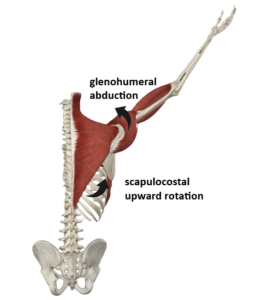Scapulohumeral Rhythm
- Whitney Lowe

Updated 4-25-24
The scapulohumeral rhythm is a critical component of shoulder mechanics, enabling the shoulder to have the greatest range of motion of any joint. The scapulohumeral rhythm is the coordinated movement between abduction at the glenohumeral joint and upward rotation at the scapulocostal (also called scapulohumeral) articulation. The scapulocostal articulation, while not an actual synovial joint, is the area where the scapula articulates with the posterior rib cage.
The scapula and humerus must move in a coordinated pattern during shoulder abduction. With full abduction of approximately 180 degrees, there will be about 120 degrees of glenohumeral abduction and 60 degrees of scapular upward rotation (Figure 1). These combined movements result in a 2:1 ratio between the glenohumeral joint and the scapulocostal articulations. This combined movement allows the glenoid fossa to maintain an optimal position for the humerus to fully abduct without hitting the underside of the scapula’s acromion process.
The scapulohumeral rhythm involves glenohumeral abduction and scapular upward rotation. The supraspinatus and deltoid muscles produce most of the force for abduction. The supraspinatus muscle remains active throughout the entire abduction movement, contrary to the common misconception that it is only active for the first 25 to 40 degrees of abduction. The serratus anterior and the upper and lower fibers of the trapezius are the primary movers of the scapular upward rotation.
Disturbances in the scapulohumeral rhythm can play a significant role in shoulder pathologies. For example, long thoracic nerve entrapment can impair the serratus anterior muscle function, leading to a winging scapula and insufficient scapular upward rotation during abduction. This can cause the humerus to hit the acromion process’s underside near the end of abduction, resulting in shoulder impingement and potential rotator cuff pathology.
Similarly, in cases of adhesive capsulitis (frozen shoulder), the glenohumeral joint capsule adheres to itself, limiting glenohumeral abduction. Attempts at abduction in this condition often result in significant substitution, with additional upward scapular rotation and lateral flexion of the torso to compensate for the limited glenohumeral motion.
Understanding proper and dysfunctional movement patterns in various joints is crucial for recognizing and evaluating the nature of specific pathologies affecting those joints. Identifying correct and dysfunctional movement patterns, we can better understand the best approach to treating various shoulder problems and restoring optimal shoulder mechanics.

